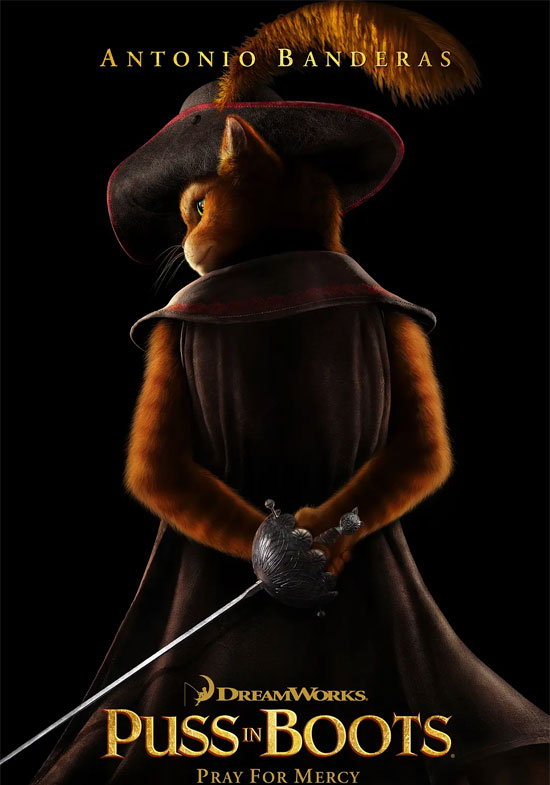Film Name: 穿靴子的猫 / Puss in Boots

This cat from the Shrek series, who sometimes transforms into a nimble swordsman and other times strikes adorably cute poses, is inherently a captivating character. If Shrek’s role as protagonist stems from the creative contrast between his ugly exterior and kind heart, then the cat’s rise from supporting role to lead is entirely due to its immense popularity. Its adorable antics are arguably the most iconic element in the Shrek films, and indeed among DreamWorks’ entire catalog.
Puss in Boots centers entirely on this feline protagonist, telling a story that stands almost entirely independent of the Shrek franchise. Two key themes drive the narrative: friendship and dignity. The film’s core explores what happens when these two values clash.
Spoilers ahead—proceed with caution!
Puss and Jack were once friends, dreaming of obtaining magic beans to reach the giant’s castle in the sky and find the goose that lays golden eggs—a source of endless wealth. But when Puss saves a villager by chance, he becomes the town’s hero. People gift him a hat and boots, but more importantly, they grant him the dignity of respect. Thus, Cat became integrated into the town’s rules and no longer agreed with Egg’s life of petty theft. However, the clever Egg used Cat to rob the town bank. When Cat realized he’d been tricked, he feared losing his hard-earned dignity in an instant. When Egg accidentally fell into the water, Cat didn’t reach out to save him.
After that, neither Cat nor Egg could survive in the town. Cat was branded a thief, stripped of his dignity, and reduced to a vagrant, while Egg obsessed over revenge. Years later, Cat—now a wandering swordsman—encountered Egg again. Egg had finally waited for his chance at vengeance. Outwardly, the Cat despised Egg for disrupting his peaceful existence—especially for shattering the dignified life he’d built within the system. Yet deep down, he still cherished the friendship they’d once shared. As the conflict between preserving dignity and honoring friendship intensified, the film’s plot reached its climax.
The stray cat carried the heartache of lost dignity alongside the guilt of abandoning his friend, turning his wandering into a solitary torment. Though he still wore the boots given to him by the townspeople—a symbol of dignity—they offered nothing more than a self-deceptive comfort. He sought an opportunity to reclaim his dignity, and also a chance to make amends for losing his friend.
With this conflicted heart, he agreed to collaborate with Dandan once more. Though the audience could clearly see Dandan was blatantly using him to obtain the goose that laid golden eggs, then framing him to achieve revenge. Dandan’s vengeance wasn’t directed solely at Cat. He also sought to lure Mother Goose to destroy the entire town, for it had treated him unfairly—denying him the dignity it had granted his friend Cat. In truth, the initial rift between Cat and Egghead stemmed from Cat gaining dignity while Egghead did not. Egghead seethed with resentment, consumed by frustration and insecurity. This drove his desire to pull Cat back into his orbit—even if it meant deceiving Cat and scheming to strip him of his heroic, dignified status.
The film concludes with a satisfying resolution. After Cat’s powerful speech, Egg returns to his kind-hearted nature—a true case of the prodigal son finding redemption. Only by being true to himself could he earn dignity. Cat, who had once been stripped of his boots by the town’s soldiers, now realized what he had been searching for during his wanderings: having friends and a heart willing to sacrifice for others is, in itself, an act of dignity.
With this realization, he saves the village once more. Though the town soldiers remain unaware, still hunting him as a fugitive, the Cat—now wearing his boots again—has transformed from a vagrant into a solitary hero. Though outside the system, he possesses a dignity that transcends it. This dignity differed from the initial sense of pride when he first donned the boots. The former was a superficial dignity he had to maintain through affectation, while the latter was an inner dignity born from becoming his true self.
The boots are the most crucial prop in “Puss in Boots.” On one hand, they symbolized the superficial dignity bestowed by others. On the other, when the cat realized that wearing them meant being his authentic self rather than the version others wanted to see, they evolved into an inner dignity. Just as the black cat could effortlessly steal the boots whenever he pleased, superficial dignity could be easily stripped away. But inner dignity could never be taken.
Please specify:Anime Phone Cases » Puss in Boots 2011 Animation Film Review: Boots are a matter of dignity.